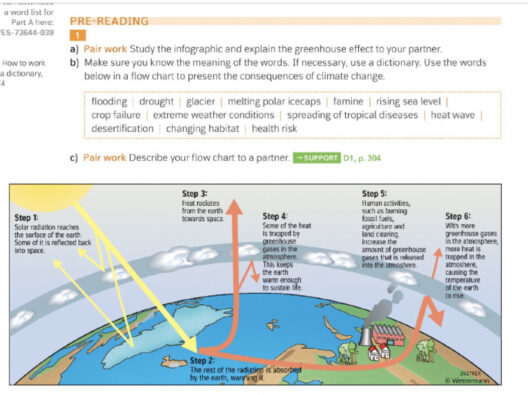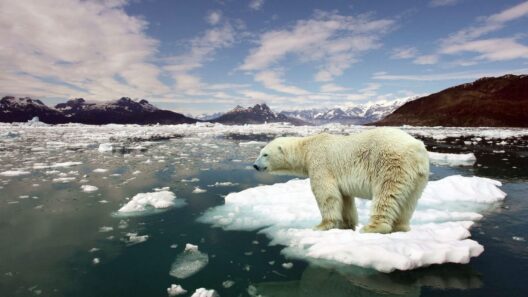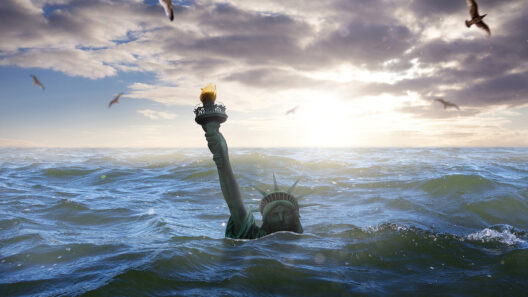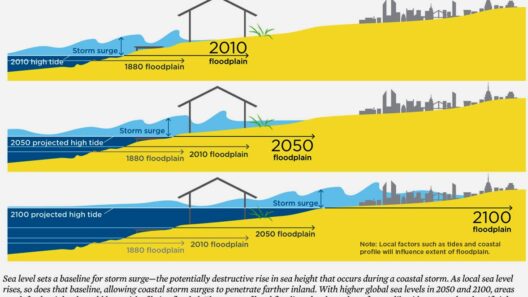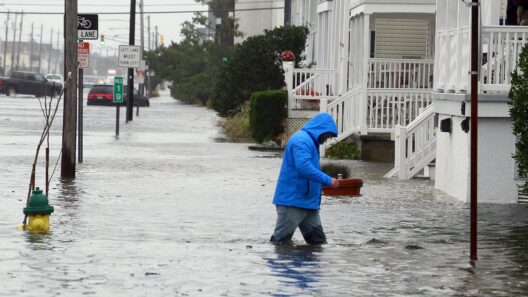Rising sea levels represent one of the most insidious consequences of climate change, a phenomenon that continues to escalate with alarming rapidity. The thermal expansion of seawater, combined with the melting of polar ice caps and glaciers, contributes to the inexorable rise of ocean levels, creating a cascade of negative implications that reverberate across ecosystems, economies, and human settlements. As the world grapples with this pressing issue, it becomes essential to explore the myriad adverse effects of rising sea levels, which extend far beyond mere coastal erosion.
Environmental Disruption: The Fragile Balance of Coastal Ecosystems
The ecosystems that cling precariously to coastlines are remarkably diverse and vibrant. Mangroves, salt marshes, and coral reefs serve as nurseries for an abundance of marine life, providing critical habitat for numerous species. However, as sea levels rise, these ecosystems face severe degradation. The inundation of freshwater wetlands and estuaries leads to salinization, which can devastate plant and animal species not adapted to higher salinity. Coastal erosion further exacerbates habitat loss, threatening countless species of wildlife with extinction.
In addition to affecting terrestrial fauna, rising sea levels also impact marine biodiversity. Coral reefs especially suffer from increased water temperatures and acidification, both of which are exacerbated by the influx of freshwater that can result from melting ice. The destruction of these underwater ecosystems diminishes biodiversity and disrupts the food chain, leading to a potential collapse of marine fisheries that countless communities rely upon for sustenance and economic security.
Socioeconomic Ramifications: The Human Cost of Inaction
The socioeconomic ramifications of rising sea levels are profound, affecting millions of people worldwide. Coastal cities, often the lifeblood of economies, are particularly vulnerable. As sea levels encroach, infrastructure—roads, houses, and sewage systems—faces inevitable inundation, leading to costly repairs or outright relocation. The financial burden of adaptation falls disproportionately on low-income communities, which are often ill-equipped to handle such disasters, exacerbating existing inequalities.
Moreover, the potential for mass displacement is alarming. The United Nations estimates that by 2050, more than 150 million people may be permanently displaced due to sea-level rise. These “climate refugees,” as they are increasingly referred to, will face significant challenges as they seek resettlement in safer areas. The movement of large populations can lead to heightened social tensions, increased competition for resources, and geopolitical instability. The fallout from this displacement may create a new class of individuals whose rights are continuously jeopardized, leading to potential humanitarian crises globally.
Health Hazards: The Overlapping Risks of Rising Oceans
As rising sea levels worsen coastal flooding, they also amplify health risks for affected populations. Stagnant water resulting from such floods becomes a breeding ground for disease-carrying vectors like mosquitoes. The proliferation of waterborne diseases—such as cholera and leptospirosis—poses a grave threat to communities that find their access to clean water compromised. Furthermore, the disruption of sanitation systems can lead to contaminated drinking water supplies, exacerbating the public health emergency.
Additionally, the psychological toll on displaced individuals cannot be underestimated. The stress and trauma associated with losing homes, livelihoods, and social networks can lead to long-term mental health issues, creating a vicious cycle of suffering. As culture and history intertwine with geography, the loss of uniquely identifiable places can trigger a profound existential crisis within communities, severely eroding their social fabric.
Economic Consequences: A Tidal Wave of Financial Cost
The economic consequences of rising sea levels are not simply a question of repairing infrastructure; they extend to insurance, real estate, and local economies more broadly. As risks mount for coastal properties, insurance companies may raise premiums or even withdraw from the market altogether, leaving homeowners and businesses scrambling for coverage. The repercussions manifest in declining property values and diminished economic opportunities, straining local governments that rely on property taxes.
Tourism, a sector vital to many coastal economies, also suffers as picturesque beaches erode and ecosystems deteriorate. The aesthetic appeal of coastal regions is intrinsically linked to their stability—once it erodes, so too does the allure for vacationers. The potential decline in tourism revenue can lead not only to job losses but also to a broader economic downturn, impacting various sectors reliant on tourism income.
Technological and Political Solutions: Navigating the Path Ahead
In the face of daunting challenges, a range of innovative technological solutions, coupled with decisive political action, could mitigate some of the negative impacts associated with rising sea levels. Coastal cities are increasingly turning to nature-based solutions, such as restoring mangroves and wetlands, to create natural barriers against flooding. Simultaneously, investments in resilient infrastructure, including seawalls and floodgates, can provide immediate protection against encroaching oceans.
Yet, the efficacy of these solutions necessitates a harmonious blend of local, national, and international cooperation. Policymakers must prioritize sustainable development, emphasizing climate resilience in urban planning. Transnational agreements focused on sea-level rise will be paramount in addressing this global issue, fostering a sense of shared responsibility among nations.
Conclusion: A Call to Action
In closing, the ramifications of rising sea levels are far-reaching, impacting not only our environment but also the socioeconomic structures that hold our societies together. As stewards of the Earth, we must act decisively to dismantle the barriers to change. Adopting sustainable practices, investing in clean energy, and advocating for the vulnerable populations disproportionately affected are not merely good options; they are moral imperatives in our fight against the rising tide. The time for action is now, for our shores and our future hang in the balance.




